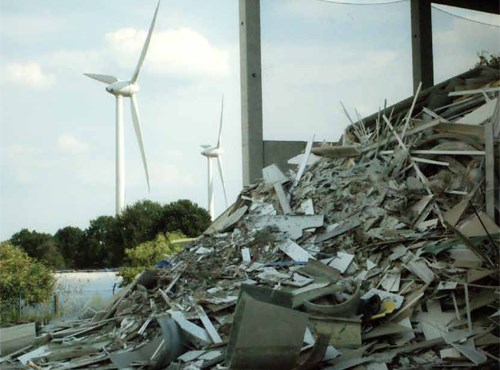Reselling, reusing composite materials and parts
The more carbon and glass fiber is used, the more it's thrown away. How the industry copes with reusable material will matter much in the coming decades. What do you do with your usable scrap?

Fiberglass composite waste piles up at Zajons, a German recycling facility.
An issue facing the composites industry right now is how to reuse and repurpose material, to avoid landfilling and to be able to label products as more environmentally “green.” Several companies have started up over the last decade to reclaim and reuse high-value carbon fiber, such as Materials Innovation Technologies (MIT, Fletcher, N.C., USA) and its spinoff company MIT-RCF (Lake City, S.C., USA), ELG Carbon Fibre Ltd. (Coseley, West Midlands, U.K.) and Adherent Technologies Inc. (Albuquerque, N.M., USA), among others. Carbon fiber’s relatively high cost makes such efforts profitable. Recycling of carbon composites has been embraced by The Boeing Co. and Airbus, among many others, to make their offerings more attractive, for one, and to develop reuse scenarios for composites that are as robust as those for aluminum, steel and other metals, which boast highly successful recycling percentages. (See our 2010 story, "Carbon fiber reclamation going commercial.")
But what about glass fiber and glass fiber products like mats? With glass fiber costing just a small fraction of carbon, recycling of glass isn’t as good a value proposition, although some companies, like Owens Corning (Toledo, Ohio, USA), are implementing programs such as fiberglass shingle recycling. In Europe, waste glass composites are being co-processed in cement kilns. CompositesWorld has been contacted on several occasions for help in finding a recycling option for either virgin or glass waste.
In one instance, the manager of a wind blade manufacturing plant in Gaspe, Quebec, Canada, was trying to meet his company’s ISO environmental standards, and had no place to send the waste dry fiber from blade layup. He asked (here’s a link to the original column, "The green challenge") for input from our readers on possible solutions. And just the other day, we got a call from a warehouse owner/operator who has some very large rolls of fiberglass mat or veil material that he wants to get rid of. We said we’d help, but so far have had zero luck in finding a use for what is likely several tons of virgin glass that will likely end up as solid waste.
So what is the answer? We’d like to hear from you on ways you’ve found to recycle glass fiber, either raw goods or cured parts. Are there entities out there that buy and sell used, old but reusable composite materials, like the large rolls of mat? Please let us know your thoughts in the comments section below.
Video of carbon fiber recycling R&D at the University of Nottingham (U.K.)
Related Content
-
Hexagon Purus Westminster: Experience, growth, new developments in hydrogen storage
Hexagon Purus scales production of Type 4 composite tanks, discusses growth, recyclability, sensors and carbon fiber supply and sustainability.
-
Composites end markets: Electronics (2024)
Increasingly, prototype and production-ready smart devices featuring thermoplastic composite cases and other components provide lightweight, optimized sustainable alternatives to metal.
-
CirculinQ: Glass fiber, recycled plastic turn paving into climate solutions
Durable, modular paving system from recycled composite filters, collects, infiltrates stormwater to reduce flooding and recharge local aquifers.















